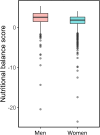The relationship between price and nutritional balance for young adults in the menus of Japanese restaurants
- PMID: 39314849
- PMCID: PMC11418817
- DOI: 10.7717/peerj.18091
The relationship between price and nutritional balance for young adults in the menus of Japanese restaurants
Abstract
Background: Eating habits are a contributing factor to obesity. Higher-priced menu items have better nutritional quality/balance, as the relationship between the price of food per serving and nutritional quality/balance has been reported. However, previous studies on the nutritional content of restaurant menu items did not focus on the relationship between the nutritional balance of menu items and prices. Therefore, this study aimed to investigate this relationship.
Methods: The nutritional balance score (NBS) was defined and calculated according to each nutritional criterion of men and women aged 18-29 years, covering more than 2,000 menu items in 26 Japanese restaurant chains. Furthermore, NBS distribution by gender and restaurant brand, and the relationship between the menu item's NBS and price were assessed.
Results: The results showed that the average NBS of the analyzed menu items differed between the criteria for men and women, with the menu items assessed based on men's criterion being more nutritionally balanced on average. The compositions of the top 10 menu items differed between men and women, and most were set menus or rice bowl menus, which were offered by fast-food restaurants. The relationship between price and NBS in most fast-food and casual restaurants was expressed as a concave function. The maximum NBS based on the criteria for men and women were 64.9 and 64.1, with prices of 639.9 and 530.3 yen, respectively.
Discussion: NBS score increased with price to a certain level before decreasing, suggesting that the price at which NBS was the highest differed between men and women. The results of this study could contribute to the development of a methodology for healthy eating out practices, with a focus on price.
Keywords: Chain restaurants; Cost performance; Menu price; Nutritional balance.
© 2024 Ogasawara et al.
Conflict of interest statement
The authors declare that they have no competing interests.
Figures




Similar articles
-
Cross-Sectional Nutritional Information and Quality of Canadian Chain Restaurant Menu Items in 2020.Am J Prev Med. 2023 Jan;64(1):42-50. doi: 10.1016/j.amepre.2022.07.015. Epub 2022 Sep 22. Am J Prev Med. 2023. PMID: 36155709
-
Nutritional quality of food items on fast-food 'kids' menus': comparisons across countries and companies.Public Health Nutr. 2014 Oct;17(10):2263-9. doi: 10.1017/S1368980013002498. Epub 2013 Oct 22. Public Health Nutr. 2014. PMID: 24148879 Free PMC article.
-
Trends in the Nutrition Profile of Menu Items at Large Burger Chain Restaurants.Am J Prev Med. 2020 Jun;58(6):e171-e179. doi: 10.1016/j.amepre.2020.01.012. Epub 2020 Mar 20. Am J Prev Med. 2020. PMID: 32201185 Free PMC article.
-
Environmental interventions to reduce the consumption of sugar-sweetened beverages and their effects on health.Cochrane Database Syst Rev. 2019 Jun 12;6(6):CD012292. doi: 10.1002/14651858.CD012292.pub2. Cochrane Database Syst Rev. 2019. PMID: 31194900 Free PMC article.
-
Restaurant Menu Labeling Policy: Review of Evidence and Controversies.Curr Obes Rep. 2016 Mar;5(1):72-80. doi: 10.1007/s13679-016-0193-z. Curr Obes Rep. 2016. PMID: 26877095 Free PMC article. Review.
References
-
- Chambers S, Lobb A, Butler LT, Traill WB. The influence of age and gender on food choice: a focus group exploration. International Journal of Consumer Studies. 2008;32(4):356–365. doi: 10.1111/j.1470-6431.2007.00642.x. - DOI
MeSH terms
LinkOut - more resources
Full Text Sources
Research Materials
Miscellaneous

